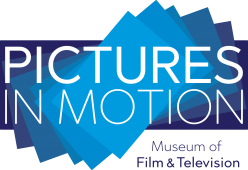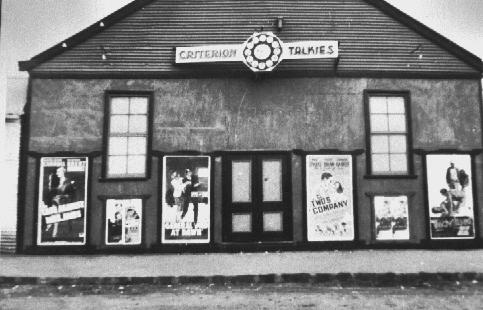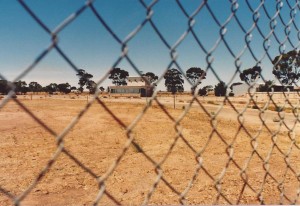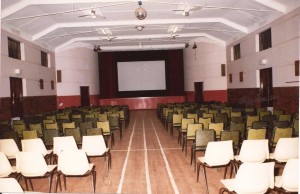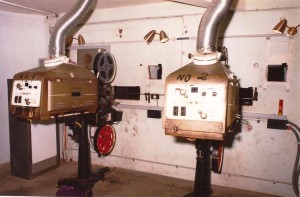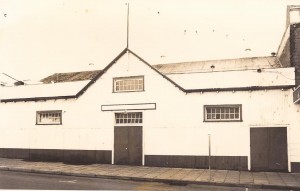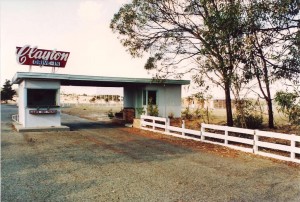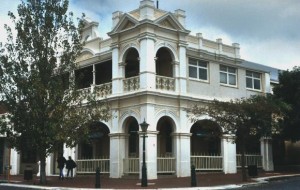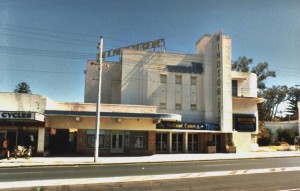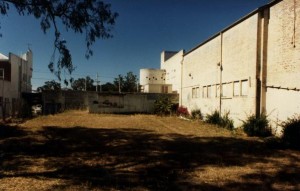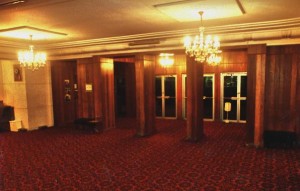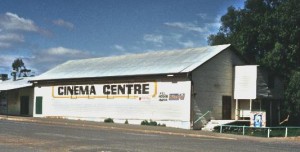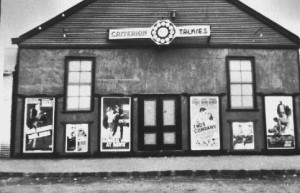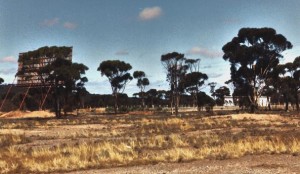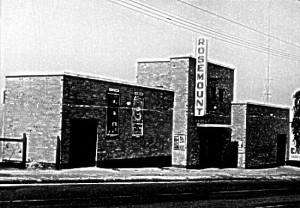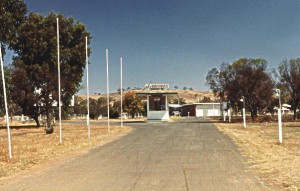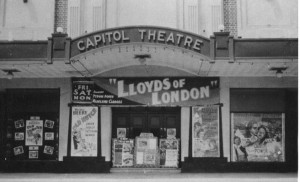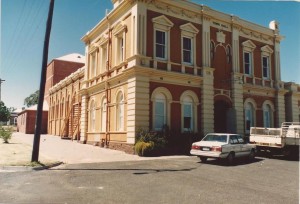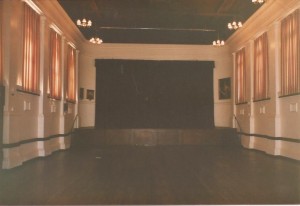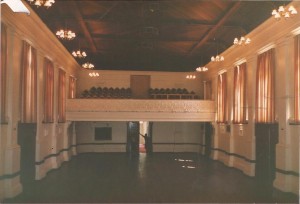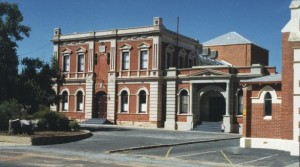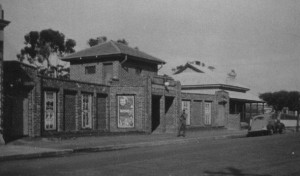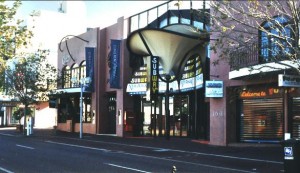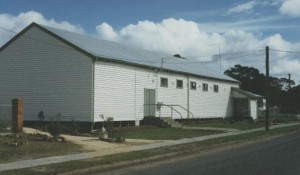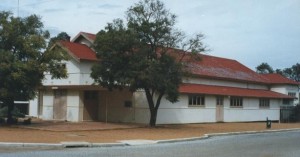Quicklinks
NABAWA
NABAWAHALL, Nabawa
Ray Dean’s West Touring Talkies was listed in the Film Weekly Directory as visiting Nabawa between 1948/9 and 1951/2.
Sources: Film Weekly Directory, 1948/9 – 1951/2
NANNUP
NANNUP TOWN HALL, Warren Rd, Nannup
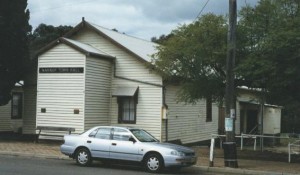
Nannup Town Hall 1997
The Agricultural Hall was built by the Farmers and Graziers Association in 1903, on the south-east corner of the intersection of Grange Rd and Warren Rd. In 1913 this became the Town Hall, and a supper room was added next door. Both buildings are of timber with corrugated iron roof. They were damaged in severe floods in 1982, and restored and reopened for the Australian bicentennial in 1988.
This hall was on Allan Jones’ circuit out of Capel at first, then Busselton, from the early forties to the late sixties. It is not clear when screenings ceased.
Sources: Film Weekly Directory , 1940/41 – 1967/8
Interview (Ina Bertrand & Irma Whitford): Allan Jones (1978)
Photo: 1 exterior, colour, 1997, Graeme Bertrand
NANSON
NANSON HALL, Nanson
Ray Dean’s West Touring Talkies was listed in the Film Weekly Directory as visiting Nanson between 1948/9 and 1951/2.
Sources: Film Weekly Directory, 1948/9 – 1951/2
NAREMBEEN
NAREMBEEN DRIVE-IN, Currall St, Narembeen
Narembeen Drive In 1987
Narembeen Drive-in opened in 1968, on Council land on the corner of Currall and Brown Streets. It was at first operated by Graham Ford and G.Negus, and held a hundred cars. It was one of Ford’s circuit of drive-ins that also included Beverly, Kondinin and Kulin, which was taken over by Brian Richard in about 1977, and closed in about 1980.
In 1997 the bio-box/concession building appeared to be in excellent repair but otherwise the site was used only as a Shire depot.
Sources: Film Weekly Directory 1968/9 – 1971
Public Health Department, building permit, Battye 1459
Max Bell, Perth – a cinema history, The Book Guild, Lewes, Sussex, 1986, p.138
Informant: Brian Richard (1997)
Photos; 1 exterior, colour, 1987, Roy Mudge
NAREMBEEN HALL
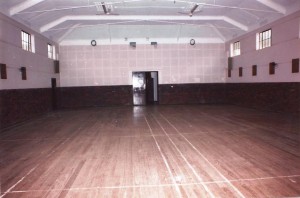
Narenbeen Hall June 1996 after opening
Projection room 1996
Photos; Interior and exterior, 1994 and 1996, colour, Roy Mudge
NARROGIN BUSHALLA’S SKATING RINK/ AMUSU, Egerton St, Narrogin
Narrogin Amuzu 1980’s
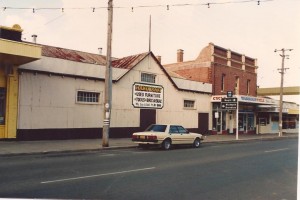
Narrogin Amuzu Front 1986
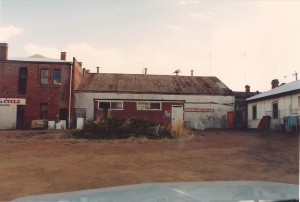
Narrogin Amuzu rear view 1986
Syrian-born Nicholas Bushalla, the proprietor of the Duke of York Hotel, built a house for himself about 1900 on the north side of Egerton St, not far up from the hotel (which was on the corner of Egerton and Federal Sts). He then built a concrete-floored skating rink, also in Egerton St, just west of his house. It is not clear when this was first built, but it was early in the century. The skating rink was said to be used for pictures once a week with the bio-box located inside Bushalla’s house, but there are no advertisements for such screenings till the twenties. However, in 1913 Nicholas Bushalla paid rates on a Picture Gardens, also in Egerton St, which seems to have been further west still, next to the skating rink, but may have been the same location. The story is told of him, as it is of Jonathan Morris of Kalgoorlie, that he saved up the threepenny bits paid as the silver coin donation for entry to the Sunday pictures till a shortage of such coins in the town forced patrons to part with sixpence instead: this may have been at the National Hall.Neville Lukey rented the premises in the early twenties and from December 1923 renamed the venue the Amusu, operating it in competition with the citizens’ group at the Town Hall. In September 1925 the lease was taken over by a local, Oswald (Ossie) Saunders, who installed new seating and projection equipment and screened three nights each week. The Amusu was not a particularly impressive building, virtually an iron shed, but it served the purpose. Competition between it and the Town Hall screenings was sometimes fierce, but both managed to remain in business for the twenties and early thirties, both under the same management from at least December 1929. Then Frank Buxton bought both leases and from August 1930 closed the screenings at the Town Hall, leaving the Amusu as the only picture venue in town. The cement floor was covered with timber, and the hall lined to make it warmer.In 1944, L.F.Wilson’s lease of the Amusu was taken over by Goldfields Pictures, the company which had begun in the goldfields, but which had by now expanded into Perth and the South West as well. In 1962 they bought new equipment for the Amusu and shifted it with them to the Town Hall, intending to upgrade the facilities there, but when the Shire would only give them a five-year lease they bought out Joe Smith’s lease on the Amusu and returned to that venue in 1965. By this time, however, the drive-in had opened, and as Goldfields Pictures was not interested in competing with the drive-in they discontinued screenings, finally surrendered their lease in September 1973, and left the town.The last of the building was demolished in 1996 and Fosseys store now stands on the site.Sources: Film Weekly Directory 1940/41 – 1971
Shire of Narrogin, Municipal Heritage Inventory
Post Office Directory 1928-1949
Public Health Department, building permit, Battye 1459
Max Bell, Perth – a cinema history, The Book Guild, Lews, Sussex, 1986, p.117
O.E.Pustkuchen, The way through: the story of Narrogin, Town of Narrogin, 1981
Max Bell, ‘Amusing musings of the Amusu’, Kino no.83, Autumn 2003, p.42
Narrogin Observer 1908-1916, 5 September 1925, 3 October 1925
West Australian 9 September 1916
Informants: O.E.Pustkuchen (1986), Sam Pope (1986), James Thornton
Interview (Ina Bertrand): Ron Elsegood (1985)
Photo: 1 exterior, b&w, n.d., Shire of Narrogin, Municipal Heritage Inventory
1 exterior, b&w, n.d., Kino no.83, Autumn 2003, p.42 (Max Bell)1 exterior, sepia , 1980’s , Max Bell2 exterior, colour, 1986, Roy Mudge
CLAYTON DRIVE-IN, cnr Bannister & Fox Sts, Narrogin
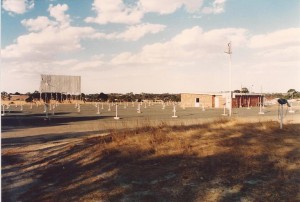

Early in 1960 two rival companies received permits to build a drive-in at Narrogin, but in the end only one was built – the Clayton Drive-in, initiated by Brian Parker with the support of the Ace group. It opened on 7 June 1960, on the north-west corner of the intersection of Clayton and Narrakine Rds. It had provision for 250 cars. It was later leased by other operators, who had increasing difficulty in maintaining it as a viable proposition, but it was still in operation once a month in 1993. In 1991, the proprietor of Narrogin Drive-in took over screenings at two other country drive-ins – Merredin and Dowerin.In 1997 it was not in use, but all the elements of the business were still there, just looking a little the worse for wear.Sources: Film Weekly Directory 1960/61 – 1971
Public Health Department, building permit, Battye 1459
Max Bell, Perth – a cinema history, The Book Guild, Lews, Sussex, 1986, p.133
Film Weekly 28 January 1960, p.3; 11 February 1960, p.4; 25 February 1960, p.3, 3 March 1960, p.11
Kino, no.36, June 1991, p.24; no.46, December 1993, p.30; no.83, Autumn 2003, p.42
Narrogin Observer , 9 June 1960
West Australian, 1977 – 1986
O.E.Pustkuchen to Colleen Pead, June 1986Photos; 3 exterior, colour, 1987, Roy MudgeEMPIRE HALL, Doney St, NarroginAbout 1911, the Empire Hall was built on the north side of Doney St, between Gordon and Garfield Streets and opposite the Cornwall Hotel (which was on the corner of Heath St). It was built for William Cornwall by H. Hunt and managed by a local farmer, Mr S.J.Miller. It was a large structure, of corrugated iron over a timber frame, and was used occasionally for film screenings during World War 1, but not after that.Later it was used as a military training facility, then the hall was demolished and commercial premises built on the site, occupied in 1997 by the Salvation army.Sources: Shire of Narrogin, Municipal Heritage Inventory
Max Bell, Perth – a cinema history, The Book Guild, Lews, Sussex, 1986, p.109
Narrogin Observer 1915-1916
O.E.Pustkuchen to Colleen Pead, June 1986
NATIONAL HALL, Lot 100, Federal St, Narrogin
Mr Bushalla, the proprietor of the Duke of York Hotel in Federal St, on the north west corner of Egerton St, built the National Hall on the north side of the hotel in 1906. It was intended for use as a performance venue, but was soon presenting pictures as well as live shows, for instance in September 1908 when Spencer’s Pictures brought films of the visit of the American fleet to Albany, and in January 1910 when West’s visited for one night only. But King’s Pictures had by December 1909 established a regular weekly screening in the National Hall, which they moved to the Town Hall in 1910 and in 1913 to the Empire Hall. Bushalla himself seems to have occasionally screened in the hall: he was reported to have introduced a Bio-megascope (a Singing and Talking machine) to the hall in 1910. National Pictures advertised intermittently from 1910 to 1915, and this may have been Bushalla’s own company as there was still an advertisement for Bushalla screening in the National Hall in September 1916. However, such references are scattered and confusing. The venue does not appear to have been used for film after 1916.In 1997, the building was completely gone and the site was the hotel car park.Sources: Shire of Narrogin, Municipal Heritage Inventory
Max Bell, Perth – a cinema history, The Book Guild, Lewes, Sussex, 1986, p.117
O.E.Pustkuchen, The way through: the story of Narrogin, Town of Narrogin, 1981
Narrogin Observer 1908-1916
West Australian 9 September 1916
Informants: O.E.Pustkuchen (Narrogin 1986), Sam Pope (1986), James Thornton
Interview (Ina Bertrand): Ron Elsegood (1985)TOWN HALL, Federal St, Narrogin
Narrogin Town Hall 1997
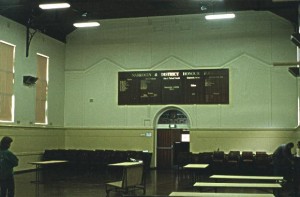
Narrogin Town Hall interior 1997
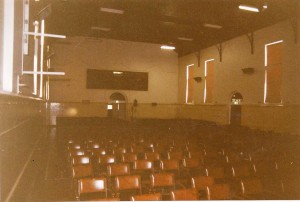
Narrogin Town Hall interior 1996
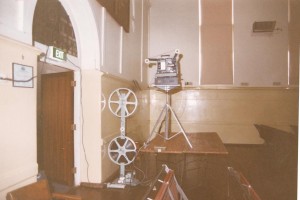
Narrogin Town Hall projection room 1996
The Narrogin Town Hall was officially opened with a ball on 9 December 1908. It was built on the south-west corner of the junction of Federal and Fortune Streets, and was soon used for occasional film screenings by visiting companies, such as the Corricks who performed for two nights in December 1909. From 1910 to 1913 King’s Pictures screened here intermittently on a Thursday. Alf Wheat (later of Geraldton) began his career in pictures operating a circuit which included Narrogin in 1913-14, before he went to the First World War. Empire Pictures screened in the hall briefly in late 1916, as did Repatriation Pictures (also known as Citizens Welfare Association Pictures) in 1918, in aid of the Returned Soldiers funds.Then no films were advertised for several years (from the end of 1918 to the middle of 1923), which means either that none were being screened, or that there was only one exhibitor and local people were so familiar with the cinema routine that no advertising was necessary.After the Amusu opened in 1923, competition between the Amusu and the Town Hall was sometimes fierce, but both venues managed to remain in business for the twenties and early thirties, both under the same management from at least December 1929. Then Frank Buxton bought both leases and from August 1930 closed the screenings at the Town Hall. In 1952/3, Goldfields Pictures moved from the Amusu to the Town Hall, intending to upgrade the facilities there, but when this proved impossible they bought out Smith and Jeffries who had taken over from them at the Amusu and returned to the Amusu.The building is still in use as a municipal facility, housing the hall and offices and an art gallery.Sources: Film Weekly Directory 1952/3
Shire of Narrogin, Municipal Heritage Inventory
Post Office Directory 1924-29
Max Bell, Perth – a cinema history, The Book Guild, Lews, Sussex, 1986, p.123
Everyone’s 9 May 1928, p.34
Narrogin Observer 1908 – 1930
Informant: O.E.Pustkuchen (Narrogin, June 1986)
Photo: 1 exterior, colour, 1997, Graeme Bertrand
1 interior, colour, 1997, Graeme Bertrand2 interior, colour, 1996, Roy Mudge
NAVAL BASE
NAVAL BASE HALL AND GARDENS, Naval Base
This hall (or perhaps just a gardens), holding approximately 100, appears to have been run by A.E. and D. Briggs from 1950 till it closed in 1963.
Sources: Film Weekly Directory, 1950/51 – 1957/8
NEDLANDS
BROADWAY AND GARDENS, 110 Broadway, Nedlands
Nedlands Pictures were operating in this area at least as early as December 1914, though it is not clear where their first screenings were held.
In about 1930, Robert Hatfield purchased the lease of the Broadway Theatre and Gardens. The theatre was comparatively small, holding about 500 people. The biobox was located on the north wall of the theatre, and could be swung round to project through portholes onto the gardens. The gardens was considerably larger, holding probably one thousand, with tiered seating at the back, a fenced off section in the middle containing the most expensive seats (deckchairs on grass), and the cheapest seats being wooden ones on both sides and in front of the fenced area.
Hatfield sold the lease to Brewers in about 1938.
Sources: Max Bell, Perth – a cinema history, The Book Guild, Lewes, Sussex, 1986, p.21
Film Weekly Directory, 1943/4 – 1960/61
Post Office Directory, 1924 -1949
West Australian, 1914, 1924 – 1958
Interview (Ina Bertrand): Colin Hatfield (1997)
DALKEITH PICTURE GARDENS, 122 Stirling Hwy, Nedlands
Robert Hatfield bought a house on the south-west corner of the Stirling Highway/ Louise Street intersection, and began to build an open air picture theatre beside it in Stirling Highway. He constructed a brick facade, set back from the street: two sets of double gates in this wall flanked a small shop fronting onto the highway. But before he opened the gardens, Nelsons opened the Windsor just up the street, and Hatfield allowed himself to be bought out of the gardens, so it was never completed or opened. The shop was used for some time afterwards as a dressmaker’s shop by two of Robert Hatfield’s daughters. Then the site was sold and became a public rose garden.Sources: Post Office Directory, 1937/8 – 1942/3
Interview (Ina Bertrand): Colin Hatfield (1997)
WINDSOR AND GARDENS/ WINDSOR TWIN, 98 Stirling Hwy, Nedlands
The Windsor theatre and gardens opened in 1937. The theatre was of art deco design, and shared a biobox with the gardens next door. It was operated by Vince Lucas till it was taken over in the sixties by Lionel Hart’s company, Independent Film Distributors, which also ran the Savoy and the Liberty (later the Kimberley) in the city of Perth. Around 1968 the gardens were closed and extensive renovations were done to the theatre:
Current work includes the panelling of entrance and foyer in elm, erection of new entrance doors, repainting of the exterior, reseating (in gold deerhide) with additional room between rows, new carpeting, new and extended proscenium curtains, new chandeliers, repainting of interior, and improvements to the men’s room and the powder room.
All speakers have been hidden, and a private logue to seat eight has been positioned to the right of the entrance stairway.
The candy bar in the foyer has been moved to one side, thus enlarging the space for patrons who wish to smoke or chat prior to the performance or at interval. (Film Weekly, 5 December 1968)
The venue survived the crisis of the sixties by becoming an art-movie house, was restored after a fire in the seventies, and was closed for some time from 24 September 1983. I987 it was bought by Cyril Watson, who also owned the New Oxford Theatre in Leederville. He built the Windsor 2 next door, on the site of the former gardens, and the new twin cinema was officially opened on 17 November 1988. Alterations were done in 1991, though Cinema 1 continued to operate throughout. There was controversy between the theatre owners and the Art Deco Society of WA when the theatre was left off the Heritage Council register in 1995. In 1997, new air-conditioning was installed.
Sources: Public Health Department, building permits, Battye Fol.2, 1459
Max Bell, Perth – a cinema history, The Book Guild, Lewes, Sussex, pp. 50-51, 67
Max Bell, ´Windsor Theatre’, Kino, no.13, September 1985, pp.8-9
Vyonne Geneve, ´William Leighton, architect’, Kino, no.25, September 1988, pp.7 – 15
Vyonne Geneve, Significant buildings of the 1930s in Western Australia, Vyonne Geneve, June 1994, National Trust of Australia (WA)/ National Estate Grants Programme, vol.1
Stage, Screen and Stars, West Australian, n.d. (1997?), p.41
Film Weekly, 5 December 1968
Film Weekly Directory, 1943/4 – 1971
Kino, no.21, September 1987, p.22; no.22, December 1987, p.23; no.23, March 1988, p.23; no.24, June 1988, p.23; no.25, September 1988, p.12; no.27, March 1989, p.23; no.38, December 1991, p.26; no.46, December 1993, p.30; no.52, June 1995, p.30; no.59, March 1997, p.31; no.63, Autumn 1998, p.35
West Australian, 1937 – 2000
Interview (Ina Bertrand): John Marsden (1997)
Photos: 2 exteriors, colour, 1981 (Bill Turner)
2 exteriors, colour, 1981 (Roy Mudge)
1 exterior (gardens site), colour, 1981 (Roy Mudge)
18 interiors, colour, 1981 (Roy Mudge)
1 exterior, b&w, 1983, Kino, no.13, p.9 (Max Bell)
1 exterior, b&w, 1986, Kino, no.25, p.15 (Byron Geneve)
1 exterior, b&w, n.d. (Max Bell, Perth – a cinema history, p.50)
NEWDEGATE
HALL, Newdegate
There seem to be two halls in Newdegate.
A small brick hall stands on the north-east corner of the junction of Francis and Collier Sts. It has a separate cement-sheet toilet block behind it, and could be just a church or scout hall. It looks about 1930s or 40s vintage.
There is also a large cement-sheet hall with a biobox built out above the central entrance doors, at the southern edge of town on the road to Lake King. It is clearly named the Newdegate Hall, but it looks quite recent – maybe 60s or 70s?
Newdegate does not seem to have had a permanent exhibitor, but certainly hosted travelling picture shows at various times in the past fifty years. It was on Columbia Talkies circuit in 1940/41, on Charles Legg’s circuit when he began in 1941, but he dropped the town off when he consolidated the circuit soon after. Around 1943, J. A. (Jack) Wilson travelled in an ex-army ´pie truck’, in a circuit that included Kukerin and Newdegate, and around 1946 that circuit was taken over by Vince Lucas. About 1980, Lyn Parker of Lake Grace screened monthly for about 18 months in Newdegate Hall, showing the same film as he screened at Lake Grace.
Sources: Film Weekly Directory 1940/41
Informant: Lyn Parker (Lake Grace, 21 August 1997)
Interview (Ina Bertrand): Charles legg (1997)
NEWMAN
DRIVE-IN, Newman Drive, Newman
N.J.Woods, who operated the open air theatre on behalf of Mount Newman Mining Co, built a drive-in for 400 cars, further up towards the mine but still on the north side of Newman Drive, set back from the road, past Fortescue Ave. This was operated for Woods by several different managers, including at one time Tony Clark and Ken Rowell. It seems to have been opened in 1972/3, was still advertising in the West Australian in 1981, and in 1981-2 was screening six nights a week (not Tuesday), with three changes of programme weekly. The kiosk was open from 6.30 p.m. till 10 p.m. every night except Tuesday, and seems to have been providing food to the general public as well as to cinema patrons. The venue closed around 1986.
The land was still vacant in mid-1997, and the remains of the drive-in could be clearly seen: the fence was standing, undulations indicated where the ramps were, and the bio-box was still there, but the site was derelict.
Sources: East Pilbara Shire Community Directory 1981-1982, pp.42, 51
West Australian 1981
Interview (Ina Bertrand): N.J.Woods (1985)
Informants: Terry (and Tora) McNamara (1997)
OPEN AIR THEATRE, Newman Drive, Newman
Around 1967 the Mount Newman Mining Co asked N.J.Woods to co-operate in the provision of a cinema for the company’s employees at Mount Newman. He put in a gardens first, adjacent to the Main Mess – a simple enclosure surrounded by a wire mesh fence, and screening twice a week (sometimes three times a week). It had provision for 150-200 patrons and was always full (listed as 350 in 1971 Film Weekly Directory). It is still clearly visible in a 1971 aerial photograph of the town, displayed on the wall of the office of the Shire of East Pilbara: it probably closed about 1972-3. By 1981, when the town became an open town (no longer a company town), there were also screenings in what was called the ‘Community Hall and Cinema’, provided on Saturday mornings for children, though the main films by then were provided in the drive-in.
Sources: East Pilbara Shire Community Directory 1981-1982, p.42
Film Weekly Directory 1969/70, 1971
Informants: Terry (and Tora) McNamara (1997)
NOLLAMARA
NOLLAMARA GARDENS, Cnr. Sylvia St and Hillsborough Drive, Nollamara
A simple open air theatre operated here from 1958 to 1966.
Sources: West Australian, 1958 – 1966
NORSEMAN
CINEMA CENTRE, Talbot St, Norseman
Pat Hogan was running the drive-in when it closed, and he went back into other pursuits.
Then he bought a deceased estate and decided to use the billiard hall behind the shop on the south-west corner of Talbot and Robert Sts as a picture show. He built a bio-box, put in tiered seats, and brought it up to government regulations in every way. He re-established contacts in the business and through them found out where equipment was available, and so he bought projectors and seats and a screen, mostly from demolished cinemas, all very old. The projector heads are vintage 1927 and 1928, fireboxes 1932 and 1934, and other parts were made up by technical people in Perth.
In 1997 he screened about once a month, more from love of the business than out of a desire for profit.
Sources: Informant: Pat Hogan (1997)
Photo: 1 exterior, colour, 1997, Graeme Bertrand
KING’S HALL/ CRITERION THEATRE AND GARDENS, Prinsep St, Norseman
Tom Waters built the Criterion Hotel in Prinsep St, on the north-west corner of Ramsay St, and also the open air skating rink beside it in Prinsep St, and the King’s Hall beside that.e rink. This hall was a long shed, corrugated iron over a timber frame, unlined and without a ceiling under the gable roof. Seating was in deckchairs, except for one row of old padded seats at the very back, reserved for the Aborigines. Sweets could be bought at the shop across the road – there was no concession inside the building.
The hall and rink were used for many community purposes, including dances and meetings, and the occasional film screening by visiting showmen such as George Ilham, who travelled irregularly between Kalgoorlie and Esperance in the early silent days (from at least as early as 1915, till at least 1925, though there may also have been other showmen – either at different times, or in competition with Ilham). He drove a T-Model Ford, with a generator in the back for his plant. He had no music, but when he was in Norseman the local people supplied a gramophone (still proudly on display in the Historical Collection, and still in working order).
Deckchairs were used in both the hall and the skating rink – moved inside if there was a shower of rain, even in the middle of a performance. In the hall, the bio-box was above the door, accessed by stairs, and the film was projected onto a screen on the stage at the far end. A similar set-up was provided in the rink, with a similar bio-box. The floor of the rink was concrete – and a pair of the old skates used there also survive in the Historical Collection.
Mort Harslett, born in Norseman in 1910, vividly remembers one occasion when Ilham showed his pictures – not in the town itself, but some miles south:
We were working putting down the Bromus Dam at McPherson’s Rocks, twenty miles south of Norseman, on the old Esperance Road, the coach road… I was only a nipper. I didn’t have a man’s job, I had a gopher’s job – you know ‘Go fer this… go fer that…’ 1924 – it could have been late 24 or early 25, I remember I was 15 years of age… George Ilham came through there. He used to travel around with his old T-model Ford, and he showed silent pictures. He got his little old generator going in the back of the Ford and he’d start winding the handle – beautiful! Now, he was coming through where we were sinking the dam and there were quite a lot of men there – about 45 men working on that dam. Billy Ray he was the head concreter. And Armstrong was the blacksmith – you had to have a blacksmith because we had three teams of horses working there and there were scoops to be repaired. And Bill Devitt he had to look after the horses. Anyhow we all had jobs to do… George Ilham said to Sydney Walter Choate (he was the engineer there) ‘You’ve got a lot of men working here. Is there any chance of me showing a picture show on my way through to Esperance?’ – he went right through to Esperance, I believe he showed at Salmon Gums on the way through. The engineer said to me, to the gopher, ‘Mort, hook up a couple of horses and tow up two big salmon gum logs to in front of Long’un Graham’s boarding house. We’re having a picture show tonight!’ Long’un Graham was our cook and he had a building there with a concrete floor and hessian walls. So, I towed the logs up and then it was time for the screen – because the hessian was just a baggy colour. And Mr and Mrs McGill was the only married couple that was there, and she took out her double sheet and pinned it on the wall of Long’un’s boarding house. I can see this as if it only happened yesterday – great excitement, and we’re all perched up on these salmon gum logs waiting for the pictures to start and old George gets his generator going and he’s got the light and he starts winding the handle and the picture opened up and I can see it today – ‘The Mine with the Iron Door’, and there were two great big hills, and right up the gully was this great, big iron door. George is winding away and nobody gave a thought to Graham’s dog, a great big alsatian called Tiger, and he was sitting on the log right alongside me because I was always chucking him bits. In the movie, an Indian comes walking out of a little side gully and this Tiger – no warning – let out a roar and he flew off that log and he got the Indian’s dog fair in the throat. He was right up off the ground as the fight started, and old Tiger was hanging there, he couldn’t get a toe hold on the ground, and his fangs went right down through Long’un’s hessian wall, and there’s a great snarling going on and he ripped things round and broke loose and the last we seen of old Tiger (it was a bright moonlight night and there were a lot of wattles there) he was going through the wattles with bits of Mrs McGill’s sheet flying behind him. We patched up the torn sheet and we made some sort of a spare and we saw the rest of the picture.
Ray Dean was an electrician: he is particularly remembered as the tradesman who connected the homes of Norseman to the power when it was eventually put on. As so often happened in country areas, electrician Ray Dean became a film exhibitor: he opened Criterion Talkies in King’s Hall in 1934, renamed it the Criterion Theatre, and for a short time he screened film in the summer in the skating rink enclosure next door.
Jack Scholey bought Dean out in 1939, and Wally Churchill operated the theatre on Scholey’s behalf. Mort Harslett remembers how terribly cold the building was, until Wally Churchill and Jack Scholey had an idea: “They got an old boiler from down the mine and the hall was up on stumps about 2ft 6 ins off the ground, and they nailed up sheets of iron all round and blocked up underneath. They used to light a fire in the boiler and they had a fan and under all the seats there was a hole bored, and it was lovely – the fan was blowing the hot air under the building and it was coming up through these holes.”
By 1943, the Criterion was listed as owned by J.Scholey, A.Nulsen, W. Tooth and G.Tooth – the same group who owned the R.A.O.B. Pictures in Esperance. Later Scholey moved to Esperance, (Emil) Nulsen moved to Perth and became a member of parliament, and the Tooths also left Norseman to live somewhere south.
In the forties the theatre and gardens each had a capacity of 450, and were screening six nights a week. Mrs May can remember that the small roofed area in the front of the skating rink was used temporarily as a frock shop in 1938-40. She can also remember attending regularly twice a week in the thirties, and later sitting in seats that were permanently booked, a few rows behind her son who sat in ´P on the aisle’. Occasionally there would be a big function on a Saturday night that involved the whole town, such as a ball: this would be held in the RSL Hall, and the picture show would be closed for the night.
The gardens seem to have closed in 1952, but screenings in the hall continued to the late seventies, ceasing only when the drive-in was built. The building (along with the shop and the skating rink) was demolished and the materials were taken south to build sheds on a property near Salmon Gums. The new Town Hall was built on the site (in approx 1982?).
Sources: Film Weekly Directory 1940/41 – 1966/7
Post Office Directory 1944-47, 1949
Max Bell, Perth, a cinema history, The Book Guild Ltd, Lews, Sussex 1986, p.107, 117-8
Interviews (Colleen Pead): R.Yelland (1986), Ray Dean (1986)
Interviews (Ina Bertrand): Ray Dean (1997), Mort Harslett (1999)
Informants: Mrs May (1997)
Photos: 1 exterior (Criterion Talkies), colour, n.d. (late 1930s), Norseman Historical Museum
NORSEMAN DRIVE-IN/CRITERION DRIVE-IN, Roberts St, Norseman
This drive-in was built on Council land, south of the railway line, between Prinsep and Roberts Sts: all its fixtures (fencing, buildings and screen) were owned by the Council. When it was first built, in 1967, it was leased to Jack Scholey (who sold the Criterion Theatre, and installed Wally Churchill as his operator), then to Bill Hattah, then to Pat Hogan.
It was closed when video became popular in the town, about 1983. The land is now in use as a Council depot: all that is left is the screen which still dominates the skyline.
Sources: Film Weekly Directory 1968/9 – 1971
Public Health Department building permit, Battye 1459
Max Bell, Perth, a cinema history, The Book Guild Ltd, Lewes, Sussex 1986, p.132
Interviews (Ina Bertrand): Alan Larkin (1985), Mort Harslett (1999)
Informant: Pat Hogan (1997)
Photo: 1 colour exterior, January 1981 (Bill Turner)
NORTH BEACH
SEA VIEW HALL AND GARDENS, 30 North Beach Rd, North Beach
By the thirties, screenings were being held in the Sea View Hall, at 30 North Beach Rd, on the south side, just east of Cain St. The hall held 200, and a gardens was opened east of the hall, running down the hill, holding about 400. These venues were built by Mr Muller and operated by Avon Payne and Roy McClure, then by R.F.McClure alone (as was the Kookaburra/Orion at Osborne Park), until closed in 1961.
Sources: Maud Thomas ´Pictures at North Beach’, in Helen Weller (ed), Recollections from a shoreline, Nineclub & Artlook Books, Perth 1980, p.22
Film Weekly Directory, 1943/4 – 1960/61
Post Office Directory, 1938/9 – 1949
West Australian, 1951 – 1960
THE CASTLE GARDENS, Flora Terrace, North Beach
The Castle Hotel was owned by Mr Toby and located on the north-west corner of the intersection of Castle St and Flora Terrace. It had a Picture Gardens, on the south-west corner of Flora Terrace and Lawley St, behind the Tennis Courts, from 1938, and people would bring rugs to keep warm in colder weather. During the war, there were frequent blackouts, caused by power shortages and the policy of electricity rationing to one-hour-on one-hour-off. When the power went off during a show, people either went home and returned an hour later, or chatted till the time passed. Don Edwards remembers:
Some excitement could be expected when the canvas deck chairs, which were in lengths of four to six seats, suddenly collapsed with the occupants disappearing from view. (Recollections, p.108)
Sources: Maylands Historical Society, July 1997
Patricia MacKenzie, ´North Beach – a post-war teenager remembers’, in Helen Weller (ed), Recollections from a shoreline, Nineclub & Artlook Books, Perth 1980, p.105
Don Edwards, in Helen Weller (ed), Recollections from a shoreline, Nineclub & Artlook Books, Perth 1980, p.108
NORTH DANDALUPHALL, North DandalupIn 1941, Charlie Legg bought Roch Evans’ Modern Cinemas circuit, including Jarrahdale, Mundijong and Serpentine and added Chidlow, North Dandalup, Hakea, Wandering and Williams to this. He already had Boddington, so these towns made up a fortnightly circuit at the start, then a little later he dropped Hakea and North Dandalup and made it a ten-day circuit, He sold his circuit to Lew Punch in 1949, who continued to screen here till at least 1951.
Sources: Film Weekly Directory, 1948/9, 1950/51 – 1951/2
Interview (Ina Bertrand): Charles Legg (1997)
NORTH PERTHROSEMOUNT AND GARDENS, 464 Fitzgerald St, Perth North
Films were screened briefly in the North Perth Town Hall in 1912 and in McLeod’s Hall in 1910 and 1916. But the first continuing screenings in North Perth were at the Rosemount Gardens, opened on a site in Angove St, next to the Rosemount Hotel on the southern side of the intersection of Angove and Fitzgerald Streets, in 1920. This venue had a brick street frontage, containing the bio-box. Inside, the whole flat seating area was grassed, with hard seats along the left side and the front, and deckchairs inside a fenced area in the middle and to the right. Babies in prams would be parked along the aisles, next to their parents. There was no concession building: patrons went out to local shops if they wished to purchase refreshments. Male ushers showed patrons to their places, though seats were not numbered.In 1924, a theatre was built to operate in conjunction with the gardens, but not next door to it: the theatre was at 464 Fitzgerald St, on the opposite side of the road, facing the Angove St intersection. It had a lesser hall, hired out for meetings even while the films were going on in the theatre. Alan Crew describes the theatre as a ´shooting gallery’ – big and cavernous and ugly. However, it was certainly solid: the local fire brigade went in during construction and tried to knock the walls down with fire hoses, but failed. A novel feature of the design was the two rows of love seats at the front of the balcony.This was one of the larger suburban venues, with both the theatre and gardens holding over 1100 people. In 1928, the theatre closed for three months for extensive renovations, and in November 1929 Australtone sound equipment was installed, making this one of the first suburban theatres to have sound, only a few months after the first sound films were screened in the city centre. Seats were numbered in the circle but not in the stalls, and ticket sellers were on duty in the afternoon booking for the evening: in the thirties and forties, the venue sold out every Saturday and most Fridays.In the early forties the venues were operated by Carl During and (H.? or A.T.?) Parker, who also ran the Ritz at Mount Hawthorn. Then, in 1949, they were taken over by Goldfields Pictures. The gardens site was leased from the hotel, so, when they took it back to extend the bar, that was the end of the first Rosemount gardens. Goldfields built a new gardens further down Fitzgerald St, towards Perth, perhaps on the north-west corner of the intersection with Alma Rd.In 1960, after it closed, it was converted into the state’s first ten-pin bowling alley, and later still into shops.Sources: Max Bell, Perth – a cinema history, The Book Guild, Lewes, Sussex, pp.46-47, 65
Everyone’s, 8 February 1928, p.27; 1 August 1928, p.16; 28 November 1928, p.43; 16 January 1929, p.24; 9 October 1929, p.21; 23 October 1929, p.18-19; 12 February 1930, p.25
Post Office Directory, 1921 – 1949
Weekend News, 10 September 1960
West Australian, 1910, 1912, 1916, 1930 – 1960
Interview (Ina Bertrand): Ron Elsegood (1985)Photos: 1 exterior (theatre), b&w, n.d (Ron Elsegood)NORTHAMAVONWAY DRIVE-IN, Mitchell St, Northam
The first drive-in in the district was the Avonway built by Ace Theatres, from Perth. It was located on Shire land, south of the town and on the west side of the road, behind the municipal swimming-pool. It opened on 31 December 1959, with provision for 350 cars.
Much of this area was within reception of Perth television, and one of the first two country television licences was at Northam in 1964, covering much of the rest of the district. The drive-in survived, however, until 1983. By 1997 all traces of it had been completely obliterated.
Sources: Film Weekly Directory 1960/61 – 1971
Public Health Department, building permit, Battye 1459
Vyonne Geneve, ´William Leighton, architect’, Kino, no.25, September 1988, pp.7 – 15
Max Bell, Perth – a cinema history, The Book Guild, Lews, Sussex 1986, p.130
Film Weekly, 7 Jan.1960, p.9
West Australian 1962, 1969 – 1983
Photo: 1 exterior, colour, 1981, Bill TurnerNORTHAM CINEMAS, 76 Wellington St, NorthamThis twin cinema was built by Dennis McKenna, in a disused squash court in the main shopping centre.OPEN AIR PICTURE GARDENS/ PALACE GARDENS/ CAPITOL THEATRE, Fitzgerald St, Northam
The Palace Gardens was on the north side of Fitzgerald St, in the middle of the block between Grey St and Gordon St. From June 1908, live musical entertainments were being advertised at the Palace Gardens occasionally. From 1910 it was used as a skating rink, and from 1911 (Max Bell says the rink was rebuilt in 1911 by A.W.Byfield) the skaters and the film fans shared the premises, films being screened on Tuesdays and Thursdays, and skating being available on Wednesdays and Saturdays.But then the Palace Gardens was roofed and became the Palace Theatre, so from 1912 it displaced the Town Hall as the main venue for films in the town. By early 1926 the Palace Theatre was owned by the Pearmine Bros, who also owned the outdoor entertainment centre further down the street, known as White City.The Palace closed for renovation in May 1929. It was intended that “extensive alterations” would take place:
The alterations comprise two new shops, and enlarged entrance, a dress circle which will accommodate 350 people, and a direct staircase leading there-to. The present seating capacity of the theatre is 1,200. This will be increased to 1,600. A splayed fibrous plaster proscenium stage front will be provided, and the entire seating of the stall floor will be re-arranged. Portion of the dress circle will be occupied with club chairs, and the remainder of the seating will be of the orthodox variety. A special enlarged projection room will be fitted with the latest cinema machinery, and space will be reserved for a possible installation of the “talkies”. In front of the orchestra will be elaborate ballustrading. (Northam Advertiser, 18 May 1929)
The venue re-opened in May 1930, but apparently without sound films, as the advertisements promised an orchestra of professional musicians for the benefit of music lovers. However, in 1931 Nelsons bought the Palace and re-opened it on 11 March 1931 as the Capitol Theatre, equipped with Raycophone sound equipment, though this was replaced with RCA Photophone just a little over a year later, in June 1932. In 1936, Goldfields Pictures bought the Capitol, and built a new gardens (on the White City/Coliseum site?) a little further up Fitzgerald St, with lawns, trees and shrubs. In 1942, the theatre held 950 and the gardens one thousand: one or the other was screening seven nights a week. The venue remained popular for many years, till the theatre was sold in 1969, and the gardens site two years later.The theatre site is now occupied by Woolworths arcade, north of the Commonwealth Banking Corporation (or was it on the south side of CBC?).Sources: Film Weekly Directory 1940/41 – 1969/70
Post Office Directory 1912-1949
Max Bell, Perth – a cinema history, The Book Guild, Lewes, Sussex, 1986, p.103
Donald S.Garden, Northam: an Avon Valley history, OUP, Melbourne 1979, p.231
Everyone’s 7 March 1928, p.18
Northam Advertiser 1908-1932
Interviews (Ina Bertrand): Norman Cunningham (1981), Ron Elsegood (1985)
Informants (all 1986): Miss Broomhill, Bud Byfield, Dink Horsley, Ted Moore, Frank Mountney, Fred Perry, Harry Rewell, Miss Sylvia Whitnell, Mrs Williams, R. YellandPhotos: 1 exterior (Capitol theatre), 1938, b&w, Ron ElsegoodTOWN HALL, Wellington St, Northam
The Northam Town Hall was built on the south-east corner of the intersection of Wellington St with Gordon St, with the Lesser Hall beside it in Wellington St. The foundation stone was laid on 21 June 1897, it opened on 21 April 1898, the supper room was added in 1901, and an Italianate facade in 1904. Repairs in 1918 included the replacement of the pressed metal ceiling with jarrah boards. The description of the building in the Northam Heritage Inventory states:
This ornate two storey civic building together with the adjoining Lesser Hall, designed by Harry J. Prockter and constructed between 1897-98, has been called Northam’s most grandiose building. These Federation Free Classical style buildings are similar at ground level, with rusticated pier edging and round-arched windows. The single level hall has a large almost semi-circular opening with associated pediment and columns. The two storey building uses a pair of engaged piers to frame the central door on its main facade. The second floor has pediments above each window and a set of ´swag’ ornaments as a part of the decorative cornice. One unusual feature is a pair of ´lancet’ openings above the doorway on the Town Hall.
Northam, so close to the state capital, was a popular location for the touring companies that screened films in the first decade, and the Town Hall was the first venue used for this purpose. It was probably used for screenings by the Salvation Army Biograph Company, which visited the town in September 1900 and October 1902. Milner’s Pictures screened in Northam Town Hall in September 1906, en route to the goldfields. The Corrick family, with Leonard’s Beautiful Pictures, visited in July 1907, and again in September-October 1909. The British and American Biograph Company appeared in March 1907, and Edison’s Popular Pictures in July that year. The Taits showed Robbery under arms in January 1908, and the English and American Kinetoscope visited in August the same year.So the town also appeared early on the schedules of the permanent circuits operating out of Perth. King’s Pictures circuit gave their first screening on 14 April 1909, and continued regularly at the Town Hall every Wednesday for some time. Geo F.Todd managed the presentation, touring with seven staff including an orchestra and effects technician, and proudly advertising that the programmes they would present were the same as those being offered in Perth. In May 1909, West’s began screening at Northam every Friday, moving to the Palace Gardens in the summer months of 1909-10, but permanently at the Town Hall from December 1910 to February 1912.In August 1914, Marden’s Popular Pictures were screening at the Town Hall, but by then the Palace had become the town’s main picture venue, and screenings at the Town Hall seem to have become irregular. In May 1929 the Palace closed for rebuilding and for a year films returned to the Town Hall, so this was where, in July 1929, patrons were invited to “SEE & HEAR…” Al Jolson in The Jazz Singer. After the Palace reopened in May 1930, regular film screenings ceased at the Town Hall.Sources: The Heritage of Western Australia: the Illustrated Register of the National Estate , Macmillan 1989, p.107
Shire of Northam,Heritage Inventory, T35
http://www.abc.net.au/limelight/docs/tours Max Bell, Perth – a cinema history, The Book Guild, Lews, Sussex 1986, p.111, 117
Northam Advertiser , 10 April 1909
West Australian 1906 – 1914
Photo: 1 exterior, colour, 1997, Graeme Bertrand
1 exterior, b&w, n.d., The Heritage of Western Australia: the Illustrated Register of the National Estate, Macmillan 1989, p.1071 exterior, 1987, colour, Roy Mudge3 interior, 1987, colour, Roy MudgeWHITE CITY/ COLISEUM GARDENS/ CAPITOL GARDENS, Fitzgerald St, Northam
In 1926, the Pearmine Bros, who owned the Palace Theatre, also owned the outdoor entertainment centre known as White City. They sold the latter, with a permit for conversion to an outdoor cinema, to Mr Buxton later that year. From 1927, the White City premises became known as the Coliseum Gardens, and they continued under this name till late 1931.It is likely that it was bought by Nelsons in 1931, when they bought the Palace Theatre – but it is not clear what happened on the site from 1931-36. In 1936, Goldfields Pictures bought the Palace Theatre from Nelsons and built the Capitol Gardens on the north side of the Northam Advertiser building (now the Avon Valley Advocate): this location is quite clear from photos of the gardens. What is not certain (although it seems likely) is whether this was also the site of the earlier White City or Coliseum Gardens. (It is possible that White City OR the Coliseum Gardens was on the other side of the road, opposite the Northam Advertiser – some old residents remember a short-lived gardens there, but disagree about what it was called)The Capitol Gardens had a substantial brick wall on the street frontage and an imposing entrance, and inside the deckchairs were laid out on lawns, and trees and shrubs planted around the walls.In 1942, the theatre held 950 and the gardens one thousand: one or the other was screening seven nights a week. The venue remained popular for many years, till the theatre was sold in 1969, and the gardens site two years later.Sources: Post Office Directory 1927-1934/5
Public Works Department, files 1656/26, 1950/26, Battye AN 7/10 AC 1004
Informants (all 1986): Miss Broomhill, Bud Byfield, Dink Horsley, Ted Moore, Frank Mountney, Fred Perry, Harry Rewell, Miss Sylvia Whitnell, Mrs Williams, R. YellandPhotos: 1 exterior (Capitol gardens), 1938, b&w, Ron Elsegood
1 interior (Capitol gardens, seating and screen), 1938, b&w, Ron Elsegood
1 interior (Capitol gardens, seating and biobox), 1938, b&w, Ron Elsegood
NORTHAMPTONDRIVE-IN, Wanerenooka Rd, NorthamptonRay Dean built this drive-in in 1965, on land leased from the Shire. It was located on the south side of Wanerenooka Rd, behind the bowling club which was on the corner of the highway. It held 120 cars, and at its peak, in the late sixties and early seventies, it screened only two or three times a week. After it closed, some of the equipment was sold to Broome. The land is now vacant – the screen and concession building demolished, the ramps slowly decaying and becoming overgrown with weeds.
Sources: Film Weekly Directory 1965/6 – 1971
Public Health Department, building permit, Battye 1459
Max Bell, Perth – a cinema history, The Book Guild, Lewes Sussex 1986, p.138
Interviews (Ina Bertrand): Ray Dean (1997), Alan Larkin
NORTHBRIDGECINEMA ABERDEEN, 59 Aberdeen St, Northbridge
New cinema screening travel films 3 times daily called Cinema Aberdeen’ (Max Bell, Kino, no.53, p.31). This cinema seems to have been in operation for a short time only, around 1995.
Sources: Kino, no.53, September 1995, p.31
West Australian, 1995CINEMA PARADISO, The Galleria, 164 James St, Northbridge
In December 1992, the first two screens of the three-screen Cinema Paradiso opened in the Northbridge Galleria building. The third opened on 22 July 1993. Cinema 1 held 183, Cinema 2 held 208, Cinema 3 held 300 – typical of the smaller cinemas, with more specialised programming, that competed with other forms of entertainment in the nineties. It seems to have been owned at first by Showcase Cinemas, the company which also owned the Astor, Mount Lawley:
then in 1997 both cinemas were operated by Palace Cinemas, which joined Ace by the end of the year. In 1999 this complex was operating as a Palace Cinemas venue
Sources: Kino, no.41, September 1992, p.27; no.43, March 1993, p.31; no.46, December 1993, p.30; no.62, Summer 1997, p.35.
Jack Honnibal, ´The theatres of Perth 1939 – 1993′, Kino no.45, September 1993, p.28
West Australian, 1993 – 1997Photos: 1 exterior, colour, 1997 (Graeme Bertrand)IMAX, Lake St, NorthbridgeKino reported in 1999:
A 300 seat theatre with a giant screen is the result of a multi-million dollar deal between the City of Perth and the firm, Multiplex Constructions. The Council’s car park in Lake Street, Perth, will be redeveloped, incorporating an IMAX Cinema.
It was later reported that Cinema Plus had won the contract for this venue, and then that it had opened on 7 December 2000. In March 2002 it was advertised for sale at $3.95 milliion but failed to sell. The final screening was 9 June 2002, and rumours circulated that the site would be redeveloped as a commercial complex.However, in 2004 it was reported that ‘The Imax Cinema has reopened under the Regent banner showing 35mm films on the Imax screen without masking. It is now known as the Regent R Max, Perths biggest screen.’ (Kino, no.87, p.38)Refs: Kino, no.67, Autumn 1999, p.31; no.69, p.35; no 75, Autumn 2001, p.35; no.80, Winter 2002, p.21; no.81, Spring 2002, p.89; no.87, Autumn 2004, p.38.PIERROT PAVILION, cnr William and James Streets, PerthLittle information is available about this venue, which opened on Monday 20 December 1910. It was advertised as located on the corner of William and James Streets, but in the post Office Directories there is no listing for a theatre on any of the four corners: it could, however, have been located behind one of the listed shops.It was described as an ´open air continental theatre’ (West Australian, 4 January 1911), a description also applied to the Star Skating Rink. The first pictures presented there were Southwood’s, which had previously been exhibited on Sundays at the King’s Picture Gardens (where Sudholz refused on principle to screen on Sunday). But the theatre took its name from the company which presented the live section of the programme – the Pierrots. Sometimes the two were combined, as when Florence Wilkins sang Alive in the Deep, apparently to accompany a film:…’during these scenes of the wildest excitement Miss Wilkins’s rich contralto voice comes as through the very storm itself to the ears of the spellbound onlookers’ (West Australian, 7 January 1911). The Pierrots presented their farewell programme on 28 January 1911, and on Monday 6 February the Leader Picture Company was advertised to begin a season. No further mention was found, however, of this season, or indeed of any further use of the premises as a venue for films.Sources: West Australian, 1910 – 1911RIALTO CINEMA GARDENS, 390-396 Newcastle St, PerthOn the outskirts of the central business district, but still technically within the inner city of Perth, was this short-lived gardens, on the northern side of Newcastle St, west of the junction with Fitzgerald St (it would now be called Northbridge). It was opened in 1926 by Bill (Bunger) Bellion, who in 1927 opened the Oxford Theatre at the corner of Oxford and Vincent Streets in Leederville. For a time, the two operated concurrently, but the Rialto was closed in 1928 and some time later the New Oxford Garden Beautiful was built to operate in conjunction with the theatre, in Newcastle Street again, but this time at the Leederville end.Sources: Post Office Directory, 1928, 1929
West Australian, 1926 – 1928
Interview (Ina Bertrand & Bill Turner): Jack Gynn (1981)
NORTHCLIFFELARSSONS HALL/ NORTHCLIFFE HALL, Zamia St, Northcliffe
This large timber hall was built along Zamia St, near the intersection with Banksia St, not long after the group settlement scheme in the area began. It was built in late 1924 by the Larsson brothers, who operated the general store. Local historian J.P.,Gabbedy describes the building of the hall like this:
…Larrson Brothers asked builder Bill Lunt to construct on Lot 2 a 24.4 m x 10.9 m hall, to be made available for community use. The hall was little more than a large shed with a dressed tongue and groove floor – unlined, without ceiling, stage or supper room. Because of the width of the hall, the roof was M-shaped: two simple pitched roofs with a valley between them. To cut the scantling and weatherboards, the Larssons paid Dick White’s mill hands to work weekends. Jack Carrigg had planned to locate his timber yards and storeroom on adjoining Lots 3 and 4. He saw certain advantages which could rub off on him and supplied the tongue and grooved flooring at cost – a tremendous saving to Larssons. In return, the owners gave Carrigg the privilege of holding his stocks of plasterboard sheets in the hall. Once it was completed, Carrigg, with right of entry, used it also to store bags of chaff for his horse teams.
The local people, enthused by the prospect of dances and picture shows in the hall, volunteered their assistance. Lunt framed the four walls on the ground and passed the word for all hands to be available at 3 p.m. on a particular afternoon to lift them into place. There was no lack of volunteers, as ‘Gundy’ Gordon had made and donated a keg of special brew to be disposed of as soon as the job was finished. His action was not entirely disinterested – he foresaw correctly there would be an increased demand for his home brew and sly grog sidelines among the dance nights and picture show crowds.
The time was late November, with the usual wind and rain, but with ‘heaves and hoes’ the four walls were in place by early dusk. It was all to no avail. Possibly, in the hurry to get to the grog, the ends were not tied in securely, or perhaps there were insufficient ‘toms’, piece of scantling angled at approximately 45 degrees with one end bedded in the ground and the other nailed to the studs. During the night the walls collapsed. It was a week or more before repairs were effected to studs and bearers, and enough helpers could be dragooned to get the walls in place again. On the second occasion there was no free grog. (Gabbedy, p.21)
When West’s Pictures let it be known that they would visit the town if a suitable venue could be provided, Larssons were persuaded to make the hall available, provided that a local committee took charge of raising the money for alterations, and the cleaning of the venue afterwards. The alterations (a supper room and stage for dance bands) were made and screenings began soon after the hall was completed. It was officially opened on Saturday 14 February 1925, the day of the first Northcliffe District Show. Alan Betts played the piano for both the dances and the picture shows.Soon after it opened, the Public Works Department insisted on strengthening the roof by the addition of pillars, which could be a nuisance:
The new pillars imposed their only real inconvenience on picture nights which burst upon the town fortnightly when Allan Jones’ travelling van set up outside the hall and aimed the projector through the main door. The pillars made viewing from the sides difficult, but the problem was easily solved by the spectators dragging into advantageous positions bags of chaff belonging to Carrigg.
Picture nights were attended by the entire town’s population and the few groupies prepared to walk, often for kilometres, for the treat; one suspects that the sixpenny entrance fee might have been a bit of a hurdle for many of them.
The operating team might well arrive late, particularly in winter with bogs and breakdowns to contend with. Even when they got going there were enforced intermissions while films were changed or repaired. Breakdowns of engine and generator were frequent – but who cared? A few hurricane lamps would be lit (too much trouble to light the pressure lamps) while the audience joked and smoked. Dog fights which broke out during the filming were instantly quelled with a well-applied kick, but in an interval – compelled or otherwise – the donneybrook was usually urged as a means of entertainment. One particular night the filming didn’t finish till two in the morning, but not a soul thought of leaving before the end. (Gabbedy, pp.106-7)
During World War 2, Allan Jones screened in the hall once a fortnight, but this reduced to once a month after television arrived. There was no power in the town, so Jones brought his own generator in his van: if it broke down he would give the audience the choice of having to wait for up to an hour while it was fixed or continuing with the picture without sound (Mrs Jones explained that their Delco power plant was very reliable, but not powerful enough after sound arrived, so they had to supplement it with a generator from an old Buick truck: this must have been the one that was unreliable, so the pictures could continue – but without sound).Patrons sat uncomfortably on long wooden benches with hard backs, but they did not mind: the hall was always full, because there was so little else to do in the town, and it was an ideal place to do your courting. Not many people owned vehicles in the early days, so the cream carters would pick people up in their vans on the way to town, and if the carters didn’t want to go to the pictures then others could not go. There were no refreshments sold, so if you wanted any you took them with you.Screenings ceased in the mid-sixties, after television became popular. The hall is still in good repair, but no longer used for pictures.Sources: J.P.Gabbedy, Group Settlement Part 2: its people: their life and time – an inside view, UWA Press, Nedlands 1988
Film Weekly Directory 1940/41 – 1967/8
Informants: Mrs D. Jones (Busselton, September 1997), Johan Flannagan (Northcliffe, September 1997)
Photo: 1 exterior, colour, 1997, Graeme Bertrand
NUNGARINARMY AMENITIES BUILDING/ OPEN AIR THEATRE, South Rd, NungarinDuring World War 2, an army ordnance depot was built in Nungarin, with a large workforce, housed in its own camp. Among the provisions made for this workforce was an amenities block in which were held dances, sports such as badminton, and regular picture shows two or three times a week. These were at first only for the residents, but later the locals were also able to attend. An outdoor theatre was constructed at the west end of the amenities block, with projectors operated from inside the hall. The area was screened along both sides, but not fully-enclosed.
The screenings stopped by about 1950, the last disposal sale of the camp equipment and buildings was in 1961, the community took over the camp swimming pool in 1963, and the amenities block no longer exists.
Sources: Olga Joukovsky-Vaisvila, Around the rock: a history of the Shire of Nungarin, Western Australia, Nungarin Shire Council 1978
Informants: ´Aunty Jim’ Farrell (1997), Bert Waterhouse (1997)TOWN HALL, Railway Ave, Nungarin
The first hall in Nungarin was the Agricultural Hall, built in about 1912. The Town Hall was built later, but I have been unable to find out just when.Harry Delavale started screening pictures in Nungarin after World War 1, touring in his van, showing about fortnightly in the Agricultural Hall. Seating was on wooden forms, then later on deckchairs, and the pianist was Jack McCorry. Paddy Baker travelled with Delavale, learning the business, till he took over from Delavale and carried on till the Second World War. ´Aunty Jim’ Farrell remembers Baker as ´a happy, cheery chap’ who always wore a boater and a flower in his buttonhole.It is possible that Rupert Morris was screening in the hall in competition with the army screenings during the war, and he was definitely screening in the hall straight after the war – he had a circuit in Nungarin, Mukinbudin and Chandler. McDougall took over from him in the mid-fifties, and was showing twice a week in Nungarin till the seventies.Sources: Film Weekly Directory 1940/41, 1942/3 – 1953/4
Olga Joukovsky-Vaisvila, Around the rock: a history of the Shire of Nungarin, Western Australia , Nungarin Shire Council 1978
Informants: ´Aunty Jim’ Farrell (1997), Bert Waterhouse (1997)
Photo: 1 exterior, colour, 1997, Graeme Bertrand
NYABINGHALL, NyabingCharles Legg visited here regularly in the early forties, before he consolidated and reduced his circuit. Then local people set up permanent facilities in the hall and took over the monthly screenings. The hall was smaller then than it is in the nineties, but was usually well attended.
Sources: Informants: Autumn Club, Katanning, 20 August 1997
Interview (Ina Bertrand): Charles Legg (1997)NYAMUPHALL, NyamupAllan Jones was listed in the Film Weekly Directory as screening here from 1948/9 to 1963/4.
Sources: Film Weekly Directory 1948/9 – 1963/4
ONGERUPONGERUP PUBLIC HALL, Eldridge St, OngerupThe first hall in Ongerup was built in the early thirties, and used as a school until the Ongerup School was opened in 1950. That hall stood where the Ongerup/Needilup District Co-op now stands, and there are no records of films being shown there.The new Ongerup Public Hall was built in Eldridge St in 1953, of asbestos and brick with an iron roof. This hall was on Frank Terry’s occasional circuit in the late seventies and early eighties.Sources: Shire of Gnowangerup, Municipal Heritage Inventory
Gnowangerup Star, 30 March 1995, p.3
Informants: Lyn Parker (1997), Frank Terry (1997)
ONSLOWOPEN AIR CINEMA, OnslowIn the early twenties, the port of Onslow was moved from the mouth of the Ashburton River to Beadon Point, and over the course of several years the township was also moved. One building transferred to the new site was the Mechanics Institute Hall, opened in the old town in February 1912 and relocated to the new town in 1926. It was a simple building, with large shutters covering the windows. It survived several fierce storms, but was completely demolished in the cyclone of 28 March 1934, and was rebuilt substantially the same as before, but with a supper room extension on one side. It is not clear whether films were screened there, but it seems likely, as I was told in Roebourne that Onslow had a picture gardens too…
Responsibility for the Mechanics Institute Hall was taken over by the Ashburton Road Board in 1932, and in 1972 new offices for what was now the West Pilbara Shire were constructed, as a new facade of the Mechanics Institute Hall.
Sources: Martyn & Audrey Webb, Edge of Empire, Artlook Books, Perth 1983
Photo: Martyn & Audrey Webb, Edge of Empire, Artlook Books, Perth 1983, p.131
ORA BANDAHALL, Johnson St, Ora BandaOra Banda was one of the boom towns of the eastern goldfields. Photos of the main street in 1913 show a bustling commercial centre, with modern facilities including (in the words of a 1990s tourist brochure): ‘ dining halls, a post office and a police station, churches, boarding houses and billiard saloons, with picture shows twice weekly, dances every Saturday night and badminton played every-other night of the week.’ Unfortunately, it does not give the dates when these picture shows took place, or any other details concerning them.The first hall was corrugated iron over an oregon frame, but it was burned down in 1932? (rumour that this was caused by the picture operator). It was rebuilt, again of corrugated iron over timber. Silent pictures were regularly screened by touring showmen, including possibly George Ilham (see Esperance).Sullivans Pictures are listed in the Film Weekly Directory as screening here between 1948/9 and 1950/51. Maureen Hill remembers breaks for reel changes and frequent interruptions for mending the film, which suggests that there was only one projector in use. At the time, in the early fifties, the town had only about 50 inhabitants, so it probably became commercially unviable for pictures.As the population declined further, the buildings deteriorated, till the hall simply fell over… In the 1990s, Ora Banda was virtually a ghost town – deserted except that the hotel had been restored as a tourist destination, and some people had returned to the few houses in the town. There are plans to improve facilities to draw more tourists, but there is no sign of the old hall.Sources: Film Weekly Directory 1948/9 – 1950/51
Interview: Maureen & Peter Hill (1999)
OSBORNE PARK ESQUIRE AND GARDENS, Scarborough Beach Rd, Osborne Park. Though this was advertised as being near the Scarborough Bus depot, Mount Hawthorn, it appears to have operated concurrently with Parker’s larger Ritz and Gardens, and to be quite separate from that venue. It opened in 1951 as just a small gardens, holding only 225, and operated by G.M. & L.E.Blinco. Later a theatre was added, holding 250, and the gardens extended to accommodate about 400. It closed about 1960.
Sources: Film Weekly Directory, 1951/2 – 1960/61
West Australian, 1953 – 1960 HALL AND GARDENS/ KOOKABURRA AND GARDENS/ ORION AND GARDENS, 204 Main St, Osborne Park.In 1935 the Kookaburra Picture Gardens seating 350-450 people opened in Main St, Osborne Park. This was apparently in a local hall with adjacent gardens built specifically for films. This venue was operated at first by Payne and McClure, then by R.F.McClure alone (as was the SeaView at North Beach), and was renamed the Orion in the early fifties. In the late fifties (unlike North Beach) it was taken over by A & E Gionotti, and it continued to screen till 1965.
Sources: Max Bell, Perth – a cinema history, The Book Guild, Lewes, Sussex, 1986, pp.36, 61
Film Weekly Directory, 1943/4 – 1964/5
Post Office Directory, 1935/6 – 1949
West Australian, 1953 – 1965
Max Bell, Perth: a cinema history, The Book Guild, Lewes, 1986 pp.48-9
Interview (Mark Turton): James McKerchar (1978)
Interview (Heather McRae?): Gladys Locke (1987) Footnote: A reader has requested clarification. The Osborne Park Esquire and Gardens Picture Theatre was at 4-6 Main St Joondanna (2020 Harold Coppock)
